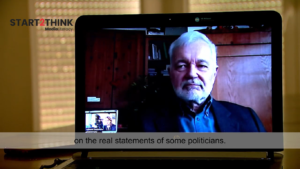
Taiwan is a territory recognized by only 14 countries and Beijing sees it as a “renegade” province that “must be united” with mainland China. Taiwan’s existence depends on the support of the United States, for which Taiwan is “the largest aircraft carrier in the Western Pacific.” But Formosa, as the island was formerly known, is also a technological powerhouse on which global semiconductor supply chains depend. Taiwan’s security has a remarkable impact on the security of the global economy, but also – in line with the European Union’s new Indo-Pacific Strategy – on the European security.
Since Xi Jinping took power in 2012, the People’s Republic of China (PRC) has been acting with an increasing assertiveness in the international arena, both on a regional and global scale. It is a peculiar attempt to “collect” those territories that were ever under Beijing’s sovereignty. Taking control over them is to constitute the political “legacy” of the present Chinese leader.
In the Indo-Pacific region, the most difficult situation and China’s most aggressive actions are visible along the coast and in the Taiwan Strait. In the East China Sea, Beijing announced an ADIZ – Air Defense Identification Zone in 2013, while in the South China Sea there is a constant expansion of the Chinese military presence along with the construction of artificial islands, violating the exclusive economic zones (EEZ) of neighboring countries and their territorial waters sovereignty. China claims 90% of that body of water[1].
The Taiwanese and Chinese
In PRC-Taiwan relations, the situation had worsened in 2016 after Ms.Tsai Ing-wen from the pro-independence Democratic Progressive Party (DPP) won the presidential election. President Tsai was re-elected in January 2020 with the support of 57% of voters[2], and she gained even greater popularity thanks to her success in managing the Covid-19 crisis. At the height of the pandemic, she enjoyed a 73% support[3].
While in power, the pro-independence party has overseen intense changes, which primarily include strengthening the sense of identity of the Taiwanese people. This process was initiated by the chairman of the National Party (Kuomintang), President Lee Teng-hui (1988-2000). He made a fundamental reform of school textbooks, which has had a serious impact on the awareness of the young generation and their perception of the island’s identity[4]. According to a survey conducted in Taiwan in September 2020, more than 80% of the residents interviewed identify themselves as “Taiwanese”, regardless of their ethnic origins. At the same time, only 2% of respondents considered themselves “Chinese” [5].
At the heart of Taiwanese identity are values more than ethnic backgrounds. These include democracy, freedom of expression and the rule of law. In Taiwanese school students are taught about indigenous peoples, European infiltration, migrations from the mainland China, varieties of the Chinese culture (or even various Chinese cultures), the 50-year long Japanese occupation and the evacuation of Chiang Kai Shek to Taiwan after the defeat in the civil war with communists in 1949.
In mainland China, all inhabitants, regardless of ethnicity (officially 55 ethnic minorities), are taught one cultural and historical heritage. Beijing, however, takes into account the changing identity of the Taiwanese as it becomes ethnically independent, and the Chinese government looks for ways to persuade the islanders to unite with the mainland. There have been several attempts of an “opening” in the past. Under Deng Xiao Ping, as China began its reforms, there was an opening in postal, commercial and transport exchanges. In 1987, Taiwan lifted a travel ban for its nationals to visit the mainland China[6]. On the Taipei side, however, the thaw has always been associated with the so-called “3 Noes” stance formulated by President Chiang Ching-kuo in 1979: no for reunification, no for independence, and no for the use of force[7]. That political legacy was taken over by the incumbent President Tsai-Ing Wen, and it is an effective tool to avoid provocations by Beijing.
Beijing, particularly in the last two decades, has also tried the formula of economic opening, creating an investment climate for Taiwanese people and scholarships for the youth[8]. However, this did not meet the Chinese expectations. The young and middle generations of Taiwanese attach great importance to democratic values, despite the undoubted pragmatism that binds all the inhabitants of East Asia, brought up in the Confucian spirit.
“One China”
Politically, the real dialogue began in 1991-1992, and it resulted in a consensus saying that there is “one China” but differently understood on both sides of the Strait[9]. However, it should be mentioned that in March 2005, China adopted the so-called anti-secession law in which, in the event of Taiwan’s declaration of independence, Beijing reserves the right to apply any measures, including a military intervention. For ordinary Chinese people, Taiwan is part of China. And this is exactly what the mentioned law says: “Taiwan is part of China. The [PRC] state will never allow secessionist forces seeking “Taiwan independence” to detach Taiwan from China under any name or by any means.” [10] So the authorities in Beijing are of the opinion that Taiwan is an internal Chinese issue.
Taipei is of a different opinion, but in line with the current government’s strategy, there is no need to aggravate the situation, although its rhetoric seems to be gradually departing from the aforementioned “One China” agreement with Beijing. On the other hand, President Tsai’s Democratic Progressive Party is not uniform when it comes to striving for independence. A large number of its members wish to maintain the status quo, being fully aware that any amendments to the Constitution would trigger an inevitable, strong reaction from Beijing[11]. On the other hand, there is a tendency to get rid of the Kuomintang and Chiang Kai Shek’s legacy, and even the name “Republic of China” – only the name “Taiwan” appears on the new passports in English. There is also a hard question of dealing with the legacy of the “Father of Modern China” – Sun Yat-sen[12].
Political system differences are an extremely interesting phenomenon that affects the difficulties in dialogue between both sides. While the central power in Beijing is increasingly authoritarian and is concentrated in the hands of one individual (Xi Jinping), the political power in Taiwan is all the time more rooted in democracy. The strengthening of democratic and separatist sentiments was largely due to the events of the past two years in Hong Kong. The incorporation of this metropolis into the Chinese jurisdiction system broke with the “one country, two systems” principle which was negotiated with the British when they handed over the city to PRC in 1997 and legally guaranteed in the constitution for that autonomous region.
“Chinese dream”
The Chinese policy towards the island is strongly informed by the conviction that the Rejuvenation of the Chinese Nation, announced by President Xi Jinping, cannot be complete without the annexation of Taiwan. On July 1, 2021, celebrating the 100th anniversary of the founding of the Communist Party of China, its current chairman stated that “Resolving the Taiwan question and realizing the full unification of China is a historic mission and the Party’s unshakeable commitment,” and those who will try to meddle in China’s affairs ” will be on a collision course with a great steel wall”[13].
Beginning on October 1 – the PRC’s national holiday – the country’s air force carried out four days of mass flights over the Taiwanese air defense identification zone[14]. In addition, also in early October, the Chinese army conducted military exercises in Fujian, on the other side of the Taiwan Strait, including a beach landing and attack[15].
The pandemic had initially weakened China’s image, but the excellent results in containing it have ultimately strengthened the government in Beijing. China is on its way to change its development model, shifting from intensive exports and international trade to a growth propelled by the domestic demand, strengthened also by the dynamically growing middle class. The long-term plan developed by the Communist party envisages that by 2035 China will become an innovative power, and by 2049 an economically developed and flourishing country. This will be the implementation of Xi Jinping’s goal, defined as the so-called “Chinese dream” or “Rejuvenation of the Chinese Nation”[16].
Taiwan is already an innovative nation. This is on that island that about 63% of world’s semiconductors is produced, including 90% based on an advanced technology. A phenomenon on a global scale is the Taiwanese company TSMC, which is responsible for 50% of the global production of microchips[17]. From this point of view, China’s renaissance is not possible without “uniting” Taiwan with mainland China.
US approach
Thus, the future of the island depends on is its role in mutual China – United States relations, and in Washington’s strategy towards the Indo-Pacific. Washington’s official position draws on its agreements with Beijing: the Shanghai Communiqué of 1972, where no deal on Taiwan was clinched; the agreement to establish diplomatic relations of December 1978, and the arrangements of August 1982, where Beijing agreed to American arms exports to Taiwan[18]. In 1979, the US Congress also passed the Taiwan Relations Act, under which Washington expresses its will to “preserve and promote broad, close, and friendly commercial, cultural and other relations between the US and Taiwan residents”. [19]
Strategically, since the Korean War the US has seen Taiwan as a sort of a “largest aircraft carrier stationed in the Western Pacific”. Nevertheless, the American strategy towards the island in the Chinese context is still the “strategy of political ambiguity”. For Taiwan, this means “ambiguity” in terms of security and uncertainty about the nature and scale of Washington’s response to a possible Chinese aggression.
The American position has changed somewhat since the Donald Trump administration and now after the Democrats and President Joe Biden took power[20]. Militarily, it also reverts to the 1951 Island Chain Strategy, which was developed by Secretary of State John Foster Dulles during the Korean War[21]. Taiwan is located in the first island chain while the second island chain covers Okinawa and Guam, where American bases are stationed. The Americans will most likely defend both of these island chains as this may make possible to block the Chinese forces. The control of the seas is essential to the control of land.
For Taiwan, the likelihood of a possible US intervention is increased by American investments in the island, which are becoming more and more substantial. However, the intervention itself – if any – will result from the strategic interests of the United States in defending its global maritime hegemony. These goals prompted Donald Trump to fundamentally change the US approach to China. The politics of engagement that has dominated the mutual relations since Nixon and Kissinger has been now replaced by a politics of strategic competition.
Despite the change of administration in Washington, there is a cross-party consensus regarding the policies towards Beijing and Taipei. It is even stronger as the United States is building its new security architecture in the region. In February 2017, Japan, India, Australia and the United States renewed the so-called Quad, a forum for dialogue and cooperation in regional security, launched in 2007 by Tokyo[22]. And on September 15, 2021, the governments of the United States, Australia and Great Britain announced the creation of AUKUS – a new partnership that is to work for security and deepening ties in the Indo-Pacific[23].
The EU position
The European Union countries have not developed a unified position on Taiwan; there are fundamental differences in this respect even within the Visegrad Group. Viktor Orban’s Hungary has strategically allied with Beijing, while official delegations from Taipei are coming to the Czech Republic. In Central Europe, Lithuania maintains the closest relations with Taiwan, where the Taiwan Representative Office was opened in November[24]. However, there are also some changes in the position of the European Union as a whole.
The new EU Indo-Pacific Strategy, announced in May 2021, mentions Taiwan five times, including in the context of China’s military assertiveness in the Strait and its impact on European security[25]. According to this document, Europe wants to strengthen ties with Taiwan, as it has with South Korea and Japan, with which EU already has international agreements: “The EU will also maintain its deep trade and investment relations with partners with whom it has no trade and investment agreements, such as Taiwan“[26].
Author: Bruno Surdel, PhD, analyst, Centre for International Relations
[1] How China is bending the rules in the South China Sea (lowyinstitute.org)
[2] Taiwan Elections: Tsai Ing-wen re-elected president with 57% of vote in final tally, says China must stop threats of force, East Asia News & Top Stories – The Straits Times
[3] Taiwan president’s approval rating reaches all-time high of 73%, 19. Mai, 2020. https://www.taiwannews.com.tw/en/news/3936547
[4] Shih-Shan H. Tsai: Lee Teng-hui and Taiwan’s Quest for Identity, Palgrave Macmillan 2005.
[5] Only 2% of Taiwanese consider themselves ‘Chinese’ | Taiwan News | 2020-09-24 18:01:00
[6] Tourism and reconciliation between Mainland China and Taiwan, Yingzhi Guo, Samuel Seongseop Kim, Dallen J. Timothy, Kuo-Ching Wang; Tourism Management 27 (2006) 997–1005.
[7] Yeong-kuang Ger: Cross-Strait Relations and the Taiwan Relations Act; American Journal of Chinese Studies
Vol. 22, Special Issue II (September 2015), s. 235-252.
[8] Daniel H. Rosen (PIIE) and Zhi Wang: The implications of China – Taiwan Economic liberalization; Peterson Institute for International Economics 2011.
[9] ‘1992 consensus’ crucial to cross-strait relations: ex-President Ma – Focus Taiwan
[10] Anti-Secession Law (Full text)(03/15/05) (mfa.gov.cn)
[11] Is the ‘1992 Consensus’ Fading Away in the Taiwan Strait? | RAND
[12] New Taiwan passport available today | Taiwan News | 2021-01-11 13:31:00
[13] Full Text: Speech by Xi Jinping at ceremony marking CPC centenary (www.gov.cn)
[14] Taiwan won’t start a war with China, defence minister says | Reuters
[15] Taiwan says don’t get too close as China defends military drills | Reuters
[16]Xi Jinping: The Governance of China: http://www.npc.gov.cn/englishnpc/xjptgoc/xjptgoc.shtml
[17] 2 charts show how much the world depends on Taiwan for semiconductors (cnbc.com)
[18] Richard Bush, Brookings Institution, Shelley Rigger, Davidson College: The Taiwan Issue and the Normalization of US-China Relations https://www.brookings.edu/wp-content/uploads/2019/01/The-Taiwan-Issue-and-the-Normalization-of-US-China-Relations-Bush-Rigger1.pdf
[19] H.R.2479 – 96th Congress (1979-1980): Taiwan Relations Act | Congress.gov | Library of Congress
[20] Why ‘Strategic Ambiguity’ Trumps ‘Strategic Clarity’ on Taiwan | Royal United Services Institute (rusi.org)
[21] China’s Reach Has Grown; So Should the Island Chains | Asia Maritime Transparency Initiative (csis.org)
[22] https://www.mofa.go.jp/press/release/press4e_001789.html
[23] https://www.gov.uk/government/news/uk-us-and-australia-launch-new-security-partnership
[24] Taiwan opens office in Lithuania, brushing aside China opposition | Reuters
[25] jointcommunication_indo_pacific_en.pdf (europa.eu)
[26] EU thanked for Indo-Pacific cooperation strategy report by MOFA – Taiwan Today
[evc_interactive_banner type=”classic” custom_link=”url:https%3A%2F%2Fmastersandrobots.tech%2F|||”]




